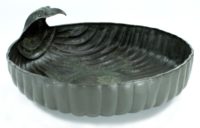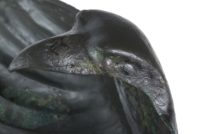 Archaeologists in Rijnsburg in the western Netherlands region of South Holland have discovered a unique eagle-headed basin from the Roman era. The site was being excavated in 2016 in advance of development of a new park when the team discovered a cremation grave from the late Roman period. Inside the grave were dozens of bronze fragments mixed in with cinerary remains of three individuals.
Archaeologists in Rijnsburg in the western Netherlands region of South Holland have discovered a unique eagle-headed basin from the Roman era. The site was being excavated in 2016 in advance of development of a new park when the team discovered a cremation grave from the late Roman period. Inside the grave were dozens of bronze fragments mixed in with cinerary remains of three individuals.
For more than a year restorers worked to puzzle the fragments back together revealing a bronze washing basin of exceptional quality. The bowl is shell-shaped, 16.5 inches in diameter with a rim four inches high. There are 33 ridges undulating across the bottom and wall. Those ridges become stylized wings where the wall transitions into the shoulders and neck of the bird of prey. The eagle’s head, its beak and eyes, are engraved in exquisite detail down to the tiny feathers on its cheeks. There are floral designs engraved on the bottom of the bowl and in a band marking the border between the wall and the wings of the eagle.
 This was not locally produced. Objects of this quality and craftsmanship were not locally produced. It was probably crafted in a specialized workshop in Italy and made its way up north with a Roman officer stationed at the nearby limes, the northern boundary of empire. Only ten such vessels have been found in Europe. This is the first one from the Netherlands, and is entirely unique in its eagle decoration.
This was not locally produced. Objects of this quality and craftsmanship were not locally produced. It was probably crafted in a specialized workshop in Italy and made its way up north with a Roman officer stationed at the nearby limes, the northern boundary of empire. Only ten such vessels have been found in Europe. This is the first one from the Netherlands, and is entirely unique in its eagle decoration.
Archaeologists believe it predates the burial. Other artifacts found in the grave, like combs made in northern Germany, indicate the deceased were likely Germanic. Their remains were buried around 330 A.D., but the basin is at least 50 years older than the other grave goods and could have been made as early as 250 A.D. It was later reused as a cinerary urn because of its great value and beauty.
[Provincial archaeologist René] Proos said the find could have been used to bribe a Germanic tribal chief: Roman generals and diplomats tried to buy the loyalty of local chiefs with gold, jewellery and bronze and silver objects.
Historians assumed the Romans left the Netherlands in the 3rd century. However, says Proos, this find, along with others from the last ten years, could mean the Roman army settled in the area again at the end of third or the beginning of the fourth century, perhaps by bribing the local chiefs.
The basin is now on display indefinitely in the Netherlands in Roman times exhibit at the Rijksmuseum van Oudheden in Leiden. It has been 3D scanned and a model created so its remarkable features can be explored in detail.